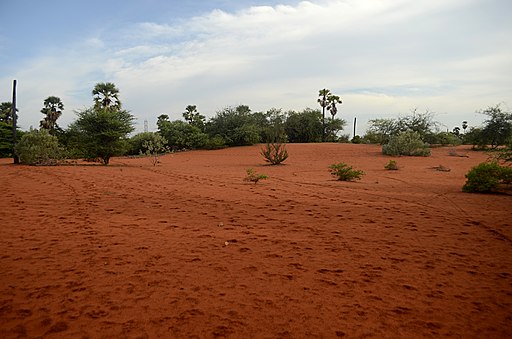Theri Kaadu or Theri or Kudiraimoli Theri is a red sand desert spread over approximately 12,000 acres of land. It is located near Thiruchendur town in Tamilnadu, India.
There are many temples in this area. Ayyanaar temples are seen in plenty. Arunchunai Kaatha Ayyanar temple is a famous temple. There are a lot of small ponds and tall trees around this temple.
This desert is a birding site. Black Rumped Flameback (a Woodpecker species), Brahminy Kites, Blue-faced Malkoha, Grey Francolins, Common iora, Kestrels, Peacocks, Pond herons, Rosy starlings, Spotted Owlets, White-breasted waterhen, etc., can also be seen here.
Butterfly species like Blue Tiger, Plain Tiger, and Crimson tip alias scarlet tip can be seen in Theri Kaadu.
Velvet Mite or Velvel Poochi is a very common mite seen here, especially after the onset of the rains. Leeches, red ants, ticks, etc, are some of the small creations found in the Teri desert.
Fan-throated Lizard is also found here.
Even though it looks like a desert, these areas receive some annual rainfall. There there are a few ponds and big trees. Palm trees and Cashew trees along with some shrubs are the primary vegetation here. Terminalia Arjuna, known as Neer Marudhu alias Arjun tree, can also be found here. Syzygium cumini, known as the black plum tree or Njaval Fruit tree, is another tree found in these red sand desserts. Many types of birds and animals eat fruit from this tree. Human beings also consume this fruit in some parts of India. It is believed that it reduces blood sugar levels in Diabetic patients.
Kids can be seen enjoying the red sand dunes. They climb the sand dunes and then slip down, like in a playground.
The details of Theri Kaadu as given in Wikipedia are cited below.
“Teri or Teri dune complex is a coastal landscape peculiar to some parts of Tamil Nadu mainly in southeastern India. The landscape consists of sediments dating to the Quaternary Period and made of marine deposits with aeolianite and characteristic red sand and silt dunes. These red soils are thought to have originated in the Pleistocene. Robert Bruce Foote hypothesized that these dunes were created by the action of winds (aeolian) lifting the fine silt fraction from further east. These dunes are oriented along the axis running parallel to the coast and between the latitudes of 8°00′ to 9°30′ N and longitudes 77°18′ to 79°00′ E. The soils also have calcium deposits replacing the old roots of vegetation. The soil is rich in Ilmenite and the red color is derived from haematite originating from garnet.”
https://en.wikipedia.org/wiki/Teri_(geology)
How Do I Go to Theri Kaadu, the Red Dessert in India?
Theri Kaadu or Teri or Teri dune complex is at Kuthiraimozhi village and Therikudiyiruppu village. It is around 15 kilometers from Thiruchendur Lord Murugan temple. There are frequent buses to this area. The Teri dune areas can be seen in many places, if you go a little inside, from the Tuticorin-Thiruchendur-Kanyakumari road.
Thiruchendur town is well connected by roads to other parts of the country. Thiruchendur railway station is the nearest railway station to the Theri sane dunes. Thoothukudi Airport is the nearest airport, though it is small with few flights. Madurai airport is the nearest major airport to the Teri Dune complex in south Tamilnadu.

